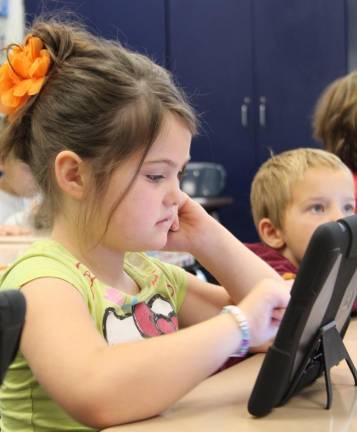Artificial intelligence: A new tool in the educator’s arsenal
Education. Classrooms across the region aren’t shying away from the potential benefits of this tech.


School districts throughout the New York, New Jersey, and Pennsylvania tri-state area are embracing the potential for artificial intelligence (AI) to enhance the learning experience for their students. While each district the Advertiser spoke with demonstrated an openness to exploring AI as a valuable teaching tool, they are approaching its implementation with caution.
Though AI itself isn’t new, its now prevalent availability and potential for misuse is a concern for educators. When tools like ChatGPT first became accessible to the public, districts around the country made headlines for their immediate ban of the tool, only to rescind on that decision a few months later.
For those unfamiliar, ChatGPT is a program that lets users type in a question or a command, like, “write me a paragraph about the history of AI,” and then generates text related to that prompt. The text is based on various sources, including scientific journals, encyclopedias, books, and other reference material.
AI as a tool in New York
Warwick Valley Central School District Superintendent David Leach likened this fear around AI to the early days of internet availability and noted that there was discussion of locking it down for students.
Instead, the district is utilizing the safeguards it already has in place to proceed with a measured approach to embracing AI tools in the district. For the Warwick Valley, this means providing gradual access to this technology, with higher grade levels receiving more.
“We want juniors and seniors to have as much experience with these tools as they head to college,” said Leach.
Leach addressed concerns over the potential misuse of tools like ChatGPT by pointing to existing strategies that show how students go through the writing process and how teachers can see if there is a big difference between the work produced at home and that produced in the classroom.
Over in Goshen, teachers and staff are being encouraged to get comfortable with emerging technologies, including AI. Dr. Kurtis Kotes, superintendent of the Goshen Central School District, described most of the district staff as “technology immigrants” who came into teaching when tech was not as big.
To account for this knowledge gap, Kotes said his district is encouraging staff to immerse themselves in the technology.
“We are allowing staff to use the school internet to explore ChatGPT and to play around with its features. We want them to see what this looks like and where the implications may come from,” said Kotes.
While the Goshen school district is encouraging teachers to explore AI and other emerging technology, it is not asking staff to use any tools they are uncomfortable with.
“We anticipate staff might come forward and ask for access, but we are not forcing staff that isn’t ready. The teachers have the support of the district.”
Regarding AI use in school, the Monroe-Woodbury Central School District offered the following statement from Bhargav Vyas, assistant superintendent, Compliance and Information Systems: “To fully harness the potential of AI, it is essential to offer comprehensive training and resources to M-W teachers. Equipping them with AI-powered tools for content creation, assessment, and personalization not only simplifies their tasks but also enriches the experience of individualized learning. Creating a collaborative environment that fosters knowledge sharing is key to driving innovation. However, it is equally crucial to address data privacy and ethical AI use from the outset to establish trust.”
Pennsylvania calls in the experts
In Pike County, the Delaware Valley School District is embracing the potential of AI to enhance the learning experience for its students. Nicole Consentino, assistant superintendent for Academic Leadership and Culture, shared that her district is bringing in experts to work with teachers.
“Our district is bringing in experts in October and January to work with teachers on ways to effectively bring AI into the classrooms and some teachers have already begun to get training in this area.”
In addition to her role as assistant superintendent, Consentino teaches 11th grade social studies and is in a unique position of having to handle the growth of AI from both an administrative and educator role.
“There are a lot of tools in that teaching tool box. It is in our best interest to maximize those capabilities.”
Unlike other districts in the area that are focusing their AI initiatives on the middle and upper grades, Delaware Valley is looking at AI as a potential tool for all students. Consentino said the district is examining the issue from a K to 12 perspective, noting that different grades will have different roles.
New Jersey embraces the AI conversation
In Vernon, NJ, efforts are being made to support students becoming good digital citizens. Nik Lasso, who started in his role as supervisor of Instructional Technology at the Vernon Township School District at the beginning of this school year, draws from his previous role as a tech integration specialist who worked closely with teachers to seek out ways AI tools might fit into the classroom setting.
The district is working with students on what AI means and when its is appropriate. For example, Lasso noted that ChatGPT could be used as a comparison tool to see how it might write an essay versus one produced by a student.
“ChatGPT doesn’t always get it right.”
According to Lasso, the discussion around AI is open to everyone.
“We are constantly open to conversation from the district, building, teacher, and student level. We want to make sure all are heard.”
In addition, Lasso said he maintains an open line of communication with other tech supervisors throughout the state of New Jersey to discuss best practices on the emerging role of AI in the classroom.
A measured approach
Overall, the sentiment around artificial intelligence seems to be cautious optimism, with leadership from the various districts embracing their potential, while recognizing the need to mitigate any potential harm.
As Leach puts it, “These tools are inevitable, how do we harness the good in them?”
“There are a lot of tools in that teaching tool box. It is in our best interest to maximize those capabilities.” - Nicole Consentino, assistant superintendent for Academic Leadership and Culture at the Delaware Valley school district.